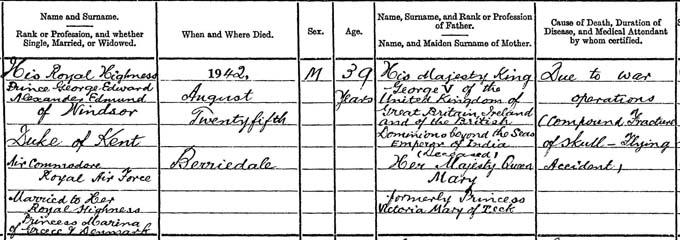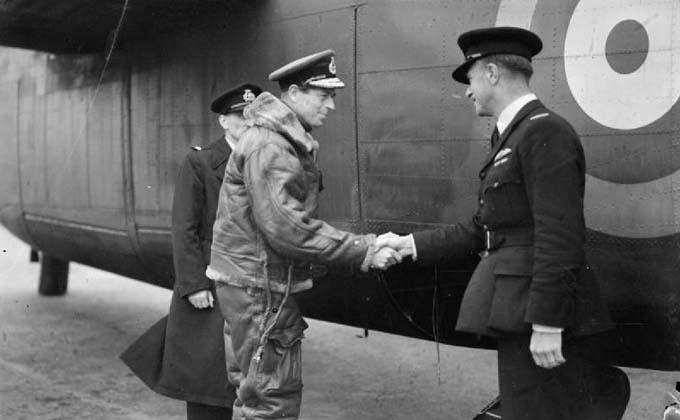The burning aircraft was first discovered by farmer David Morrison and his son, Hugh, as they searched the Caithness countryside for their sheep on 25 August 1942. They had heard the sound of the engines overhead and then a muffled explosion as the patrol bomber hit the hillside at Eagle's Rock near Dunbeath.
The RAF S.25 Short Sunderland Mark III flying boat had been en route to Iceland when it crashed near the east coast of Scotland. There was only one survivor Flight Sergeant Andrew Wilson Jack, aged 24 from Grangemouth. The rear gunner in the aircraft, he was thrown clear when the plane hit the hillside. Permission to proceed with the visit to Iceland had only been granted by the King earlier in the week.
Sitting alongside Flight-Sergeant Jack was His Royal Highness Prince George, the Duke of Kent, brother to the King. Known in Scotland as The Earl of St Andrews, Prince George was accompanied by Lieutenant John Lowther, his secretary for seven years, and his Air Equerry, Pilot Officer the Hon. Michael Strutt. Flying the aircraft was Flight-Lieutenant Frank McKenzie Goyen. In total, there were 15 fatalities.
The victims of the crash are recorded in the statutory register of deaths for the district of Latheron.

Detail from the death entry for His Royal Highness, The Duke of Kent, 25 August 1942
National Records of Scotland (NRS), Statutory Register of Deaths, Latheron, 038/58 page 20
Since the age of 13, Prince George had served in the forces. First attending naval college in 1915, he rose through the ranks and was made captain in 1937. The same year he was also commissioned as a colonel in the British Army and in the equivalent rank of group captain in the Royal Air Force (RAF). The outbreak of war saw these positions rise to rear admiral in the Royal Navy, major-general in the British Army and air-vice marshal in the RAF.
In April 1940 he renounced his honorary title in the RAF, believing that this made him senior to many other men who had greater experience. He became a Group Captain in the Training Command, tasked with supervising welfare work at the larger air force stations and boosting morale.

A photograph of The Duke of Kent shaking hands with the pilot of the aircraft taking him from Prestwick to Canada - the first time a member of the Royal Family crossed the Atlantic by aircraft. (Detail)
Source: Imperial War Museums, CH 3161, Royal Air Force Ferry Command, 1941-1943. Public Domain.
Prince George was created Duke of Kent, Earl of St Andrews, and Baron Downpatrick, shortly before his marriage to Princess Marina of Greece and Denmark; they married at Westminster Abbey on 29 November 1934. They had three children: Prince Edward, Princess Alexandra and Prince Michael. Prince Michael was born less than two months before his father's death, and his baptism was the last official royal event that the Duke attended.
Immediately after the crash, the Duke's body was temporarily laid to rest with the other victims of the crash before being brought to London and buried in the Royal vault at St. George's Chapel, Windsor. In August 1968, the day before his wife's funeral, his body was transferred to The Royal Burial Ground at Frogmore, where Princess Marina was also buried.
The Liverpool Echo reported on 7 October 1942 that an inquiry had found the aircraft was flown on track other than that indicated in the flight plan given to the pilot and at too low altitude to clear rising ground on track. Weather encountered should have presented no difficulties to experienced pilot and examination showed that the engines were under power when aircraft struck ground.
Despite this, various conspiracy theories spread including the belief that it was in fact the Duke who was flying the plane, that it was on its way to Sweden for peace talks with Germany and that the captain's flight plan and the subsequent inquiry papers were all lost. Whatever the reason for the crash, 15 families had lost their loved ones.
After a short period of mourning, Princess Marina busied herself by resuming her royal duties. Shortly after the accident, she visited the families of the men who had died. She also visited the site of the crash, where a granite cross had been erected in memoriam, both during the war and on the 10th anniversary with her three children.